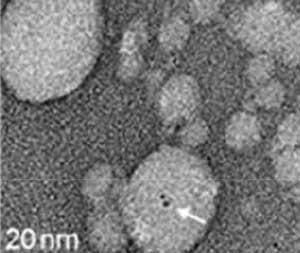Janus particles swim to site of damaged electrical circuit and get it working again

The most sophisticated electronic device can be laid low by a microscopic crack – a break in a conductive path, too small to see, or to solder. US scientists have now developed self-propelled nanomotors that could seek out and repair damaged components autonomously.
The nanomotors are based on a two-faced Janus particle design. One half of a gold nanoparticle is coated in platinum, which catalyses the decomposition of a hydrogen peroxide solution. The resulting oxygen emission jets the nanoparticle through the solution, exploring space far more efficiently than would be possible through Brownian motion alone. Jinxing Li at the University of California, San Diego, US, has been developing these particles for years.
Inspired by the way blood platelets aggregate to close a wound, Li predicted that if his particles encountered a break in a circuit, they could bridge the gap and restore electrical contact. But to do so the nanomotors must be able to ‘detect’ a broken circuit.
‘We functionalised the gold surface of the nanomotors with octadecanethiol,’ says Li. ‘This enhances their interaction with the more hydrophobic insulating substrate that is exposed when a gold electrode cracks or is scratched. It also strengthens interactions between different motors.’
The size of the nanoparticles is also important. A 0.5–2.2µm scratch in an electrode, typical of the cracks in microelectronic devices and circuits, creates a valley just the right size to capture the nanomotors as they jet over the surface.
When a droplet of hydrogen peroxide solution was placed on a scratched gold electrode, Li showed more than half of the particles accumulated in the scratches, at least partially restoring the circuit. The nanoparticles’ motion also ensures that the particles are less likely to stick to the surface outside of the crack. In a control experiment, nanomotors without the hydrogen peroxide fuel failed to perform a good repair.
Li predicts that this system will be particularly useful for electronics that are difficult to repair such as solar cells, or in flexible electronics and batteries.
Li’s work ‘very cleverly exploits one of the properties of chemically powered nanomotors’, says Tom Mallouk of Pennsylvania State University in the US.
References
J Li et al, Nano Lett., 2015, 15, 7077 (DOI: 10.1021/acs.nanolett.5b03140)












No comments yet